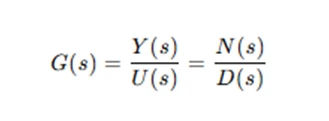Solving Transfer Function Problems in Feedback Control Systems Using MATLAB

Feedback control systems play a pivotal role in modern engineering, enabling precise control over dynamic systems such as robots, vehicles, and industrial machinery. For engineering students and professionals, mastering the intricacies of feedback control systems often involves solving transfer function problems. MATLAB, a powerful computational tool, simplifies these tasks significantly, providing an efficient platform for analysis, design, and simulation. If you're looking to solve your Control Systems Assignment, MATLAB's versatile functionalities make it a perfect choice.
In this blog, we will explore how MATLAB can be employed to solve transfer function problems in feedback control systems. Whether you're a student seeking MATLAB assignment help or a professional refining your skills, this comprehensive guide will walk you through the concepts and practical applications of MATLAB in this domain.

Transfer Functions in Feedback Control Systems
A transfer function represents the relationship between the input and output of a system in the Laplace domain. It provides a mathematical model for analyzing the behavior of dynamic systems and is expressed as:

where:
- G(s) is the transfer function.
- Y(s) is the Laplace transform of the output.
- U(s) is the Laplace transform of the input.
- N(s) and D(s) are polynomials in s representing the numerator and denominator, respectively.
In feedback control systems, transfer functions help design controllers, analyze system stability, and predict system performance. MATLAB offers several tools and functions to manage these tasks efficiently.
Why Use MATLAB for Transfer Function Analysis?
MATLAB is a popular choice for solving control system problems due to its robust set of built-in functions and toolboxes, including the Control System Toolbox. Here are some reasons why MATLAB is indispensable:
- Ease of Use: MATLAB's syntax is intuitive, allowing users to define transfer functions and analyze systems with minimal effort.
- Visualization Tools: MATLAB provides advanced plotting capabilities for Bode plots, Nyquist plots, and step responses, which are essential for system analysis.
- Simulation Capabilities: Simulink, integrated with MATLAB, facilitates dynamic system simulation and modeling.
- Comprehensive Documentation: MATLAB's extensive documentation and online resources make it easier to learn and troubleshoot.
If you're tackling a complex "MATLAB assignment help" request or delving into a research project, MATLAB's user-friendly interface and extensive libraries make it an ideal platform.
Key MATLAB Commands for Transfer Function Problems
Before diving into examples, let's familiarize ourselves with some essential MATLAB commands for handling transfer functions:
- tf: Creates transfer function models.
- step: Plots the step response of a system.
- impulse: Plots the impulse response of a system.
- bode: Generates Bode plots for frequency response analysis.
- nyquist: Plots the Nyquist diagram of a system.
- feedback: Computes the closed-loop transfer function of a feedback system.
- pzmap: Generates pole-zero maps.
Example 1: Defining a Transfer Function
Let’s start with a basic example of defining a transfer function in MATLAB. Consider the following transfer function:
% Define numerator and denominator coefficients
num = [10];
den = [1 2 10];
% Create transfer function
H = tf(num, den);
% Display the transfer function
disp('Transfer Function:');
display(H);
Output:
Transfer Function:
10
----------------
s^2 + 2 s + 10
Example 2: Analyzing System Response
One of the primary tasks in control systems is analyzing the time-domain response of a system. MATLAB can compute and plot the step and impulse responses easily.
Step Response:
% Plot step response
step(H);
title('Step Response');
Impulse Response:
% Plot impulse response
impulse(H);
title('Impulse Response');
These plots provide insights into the system’s transient and steady-state behavior, which is crucial for controller design and performance evaluation.
Example 3: Frequency Response Analysis
Frequency response analysis is essential for understanding system stability and performance. MATLAB’s bode and nyquist functions are particularly useful for this purpose.
Bode Plot:
% Generate Bode plot
bode(H);
grid on;
title('Bode Plot');
Nyquist Plot:
% Generate Nyquist plot
nyquist(H);
grid on;
title('Nyquist Plot');
These plots are invaluable for analyzing gain and phase margins, which are critical for ensuring system stability.
Example 4: Closed-Loop System Analysis
Consider a feedback control system with the following configuration:
- Plant transfer function: .
- Controller transfer function: .
The closed-loop transfer function is given by:
% Define plant and controller transfer functions
P = tf([10], [1 2 10]);
C = tf([5], [1 1]);
% Compute closed-loop transfer function
T = feedback(P * C, 1);
% Display closed-loop transfer function
disp('Closed-Loop Transfer Function:');
display(T);
% Plot step response of closed-loop system
step(T);
title('Closed-Loop Step Response');
Example 5: Pole-Zero Analysis
Poles and zeros of a transfer function provide critical insights into system stability and dynamics. MATLAB’s pzmap function visualizes these characteristics.
% Generate pole-zero map
pzmap(H);
grid on;
title('Pole-Zero Map');
The pole-zero map reveals the location of system poles and zeros in the complex plane, helping assess stability and response characteristics.
Advanced Applications
Beyond the basic examples, MATLAB supports advanced techniques for solving complex transfer function problems, including:
- Root Locus Analysis: MATLAB’s rlocus function plots root locus diagrams, aiding in controller design.
- State-Space Representation: MATLAB allows conversion between transfer function and state-space representations using tf2ss and ss2tf functions.
- Controller Tuning:Use MATLAB’s Control System Designer for PID tuning and advanced controller design.
% Plot root locus
rlocus(H);
title('Root Locus');
% Convert transfer function to state-space
[A, B, C, D] = tf2ss(num, den);
disp('State-Space Representation:');
display(A); display(B); display(C); display(D);
```matlab
controlSystemDesigner(H);
Practical Tips for Using MATLAB Effectively
To "solve your Control Systems Assignment" or tackle real-world problems efficiently, consider the following tips:
- Leverage Documentation: MATLAB’s built-in help and online resources are excellent for learning and troubleshooting.
- Use Scripts: Organize your code into scripts for better readability and reusability.
- Visualize Results: Always plot system responses to validate your analysis.
- Simulink Integration: For complex systems, use Simulink for dynamic simulations.
- Experiment: Don’t hesitate to try different approaches or tweak parameters to deepen your understanding.
Conclusion
MATLAB is a powerful tool for solving transfer function problems in feedback control systems. From defining transfer functions to analyzing system responses and designing controllers, MATLAB simplifies complex tasks, making it an indispensable resource for students and professionals alike. If you're seeking MATLAB assignment help, mastering these techniques will enhance your problem-solving skills and prepare you for advanced applications.